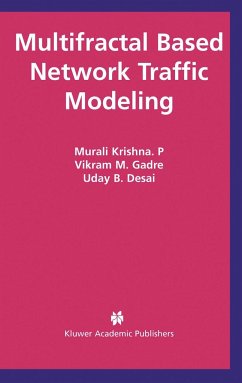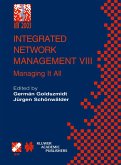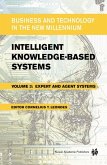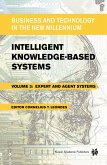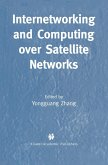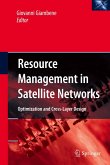- Gebundenes Buch
- Merkliste
- Auf die Merkliste
- Bewerten Bewerten
- Teilen
- Produkt teilen
- Produkterinnerung
- Produkterinnerung
Multifractal Based Network Traffic Modeling provides an overview of existing broadband traffic modeling based on the Poisson process and its variants like the MM1 models. It also provides very good coverage of models based on self-similar processes. Throughout the book, the authors have focused on the problem of broadband traffic modeling keeping in mind long range dependencies in broadband traffic.
Graduate students, researchers, and individuals new to the areas of teletraffic modeling and communication network engineering will find this work especially helpful. The book could also be used…mehr
Andere Kunden interessierten sich auch für
![Integrated Network Management VIII Integrated Network Management VIII]() Germ n Goldszmidt / Jürgen Schönwälder (Hgg.)Integrated Network Management VIII191,99 €
Germ n Goldszmidt / Jürgen Schönwälder (Hgg.)Integrated Network Management VIII191,99 €![Protocols for High-Efficiency Wireless Networks Protocols for High-Efficiency Wireless Networks]() Alessandro AndreadisProtocols for High-Efficiency Wireless Networks125,99 €
Alessandro AndreadisProtocols for High-Efficiency Wireless Networks125,99 €![Wireless Technology Wireless Technology]() Wireless Technology194,99 €
Wireless Technology194,99 €![Protocols for High-Efficiency Wireless Networks Protocols for High-Efficiency Wireless Networks]() Alessandro AndreadisProtocols for High-Efficiency Wireless Networks191,99 €
Alessandro AndreadisProtocols for High-Efficiency Wireless Networks191,99 €![Broadband Satellite Communications for Internet Access Broadband Satellite Communications for Internet Access]() Sastri L. KotaBroadband Satellite Communications for Internet Access125,99 €
Sastri L. KotaBroadband Satellite Communications for Internet Access125,99 €![Internetworking and Computing Over Satellite Networks Internetworking and Computing Over Satellite Networks]() Yongguang Zhang (Hrsg.)Internetworking and Computing Over Satellite Networks123,99 €
Yongguang Zhang (Hrsg.)Internetworking and Computing Over Satellite Networks123,99 €![Resource Management in Satellite Networks Resource Management in Satellite Networks]() Giovanni Giambene (ed.)Resource Management in Satellite Networks121,99 €
Giovanni Giambene (ed.)Resource Management in Satellite Networks121,99 €-
-
-
Multifractal Based Network Traffic Modeling provides an overview of existing broadband traffic modeling based on the Poisson process and its variants like the MM1 models. It also provides very good coverage of models based on self-similar processes. Throughout the book, the authors have focused on the problem of broadband traffic modeling keeping in mind long range dependencies in broadband traffic.
Graduate students, researchers, and individuals new to the areas of teletraffic modeling and communication network engineering will find this work especially helpful. The book could also be used as a textbook for a graduate level course on Teletraffic Modeling.
Hinweis: Dieser Artikel kann nur an eine deutsche Lieferadresse ausgeliefert werden.
Graduate students, researchers, and individuals new to the areas of teletraffic modeling and communication network engineering will find this work especially helpful. The book could also be used as a textbook for a graduate level course on Teletraffic Modeling.
Hinweis: Dieser Artikel kann nur an eine deutsche Lieferadresse ausgeliefert werden.
Produktdetails
- Produktdetails
- Verlag: Springer / Springer US / Springer, Berlin
- Artikelnr. des Verlages: 978-1-4020-7566-7
- 2003 edition
- Seitenzahl: 210
- Erscheinungstermin: 31. Dezember 2003
- Englisch
- Abmessung: 243mm x 164mm x 19mm
- Gewicht: 1150g
- ISBN-13: 9781402075667
- ISBN-10: 1402075669
- Artikelnr.: 21709991
- Herstellerkennzeichnung
- Libri GmbH
- Europaallee 1
- 36244 Bad Hersfeld
- gpsr@libri.de
- Verlag: Springer / Springer US / Springer, Berlin
- Artikelnr. des Verlages: 978-1-4020-7566-7
- 2003 edition
- Seitenzahl: 210
- Erscheinungstermin: 31. Dezember 2003
- Englisch
- Abmessung: 243mm x 164mm x 19mm
- Gewicht: 1150g
- ISBN-13: 9781402075667
- ISBN-10: 1402075669
- Artikelnr.: 21709991
- Herstellerkennzeichnung
- Libri GmbH
- Europaallee 1
- 36244 Bad Hersfeld
- gpsr@libri.de
1. Introduction.- 1 Complexity of Broadband Network Traffic.- 2 Teletraffic Modeling: Historical Perspective.- 3 Motivation for the Problem.- 4 Contributions of the Monograph.- 5 Organization of the Monograph.- 2. Mathematical Preliminaries.- 1 Random Processes.- 2 Bernoulli (Counting) Process.- 3 Poisson Process.- 3.1 Applications to Queuing Theory.- 4 Markov Process.- 5 Independent Increment Processes.- 6 Self Similar Processes.- 7 Fractional Brownian Motion.- 8 Heavy Tailed Processes.- 9 Analysis and Estimation Techniques for Self Similar Processes.- 10 Wavelet Based Analysis of Self Similar Process.- 11 The Need for Multifractal Processes.- 12 Salient points from the chapter.- 3. Broadband Network Traffic Modeling.- 1 Broadband Network Traffic Characteristics.- 2 Network Traffic Modeling Methodology.- 3 State-of-the-Art in Teletraffic Modeling.- 4 Video Traffic Modeling.- 5 Summary of Broadband Traffic Models.- 4. Multiplicative Cascades.- 1 Binomial Multiplicative Cascade.- 2 Characterizing Multifractals through Multifractal Spectrum.- 3 Methods to Estimate Multifractal Spectrum.- 4 Interpreting the Multifractal Spectrum.- 5 Generalized Dimensions.- 6 Summary of the Chapter.- 5. V.V.G.M Multifractal Model.- 1 Development of V.V.G.M Multifractal Model.- 2 Statistical Comparison Tests.- 3 Test for Robustness of the Parametric Model.- 4 Performance and Queuing Tests.- 5 Inter Departure Process.- 6 V.V.G.M and MWM : A Comparison.- 7 Salient Points of the V.V.G.M Model.- 6. Analysis of the Multiplexing of Traffic.- 1 Analysis of Multiplexing using V.V.G.M Model.- 2 Analysis of Multiplexing using Multifractal Spectrum.- 3 Analysis of the Multiplexing using Entropy.- 4 How Complex is Inter Arrival Data?.- 5 Salient points from the chapter.- 7. Modeling of VBR Video Traces.- 1 VBR Video Modeling Using Multifractals.- 2 Statistical Tests for Model Evaluation.- 3 Results of Queuing Simulations.- 4 Complexity of VBR Video Traces.- 5 Salient points from the Chapter.- 8. Qos Issues and Control of Broadband Traffic.- 1 Statistics of Multiplicative Cascade Processes.- 2 Queuing Theory for Cascade Processes.- 3 Effective Bandwidth Estimation for QoS.- 4 Estimation and Prediction of Burstiness.- 5 Salient points from the chapter.- 9. Conclusions.- 1 V.V.G.M Cascade Process for Broadband Network Traffic.- 2 Future Work.- Appendices.- A. Wavelet Transform.- B. Legendre Transform.- C. Large Deviation Theory.- D. Norros's Queuing Model.- D.1 Parameterizing QoS Requirements.- D.1.1 Parameterizing Buffer Length.- D.1.2 Parameterizing Service Rate.- D.1.3 Parameterizing Queue Length Distribution.- E. Effective Bandwidth.- E.1 Properties.- E.2 Application in Queuing Systems.- F. Kaiman Filter.- G. Some Websites of Interest.- References.
1. Introduction.- 1 Complexity of Broadband Network Traffic.- 2 Teletraffic Modeling: Historical Perspective.- 3 Motivation for the Problem.- 4 Contributions of the Monograph.- 5 Organization of the Monograph.- 2. Mathematical Preliminaries.- 1 Random Processes.- 2 Bernoulli (Counting) Process.- 3 Poisson Process.- 3.1 Applications to Queuing Theory.- 4 Markov Process.- 5 Independent Increment Processes.- 6 Self Similar Processes.- 7 Fractional Brownian Motion.- 8 Heavy Tailed Processes.- 9 Analysis and Estimation Techniques for Self Similar Processes.- 10 Wavelet Based Analysis of Self Similar Process.- 11 The Need for Multifractal Processes.- 12 Salient points from the chapter.- 3. Broadband Network Traffic Modeling.- 1 Broadband Network Traffic Characteristics.- 2 Network Traffic Modeling Methodology.- 3 State-of-the-Art in Teletraffic Modeling.- 4 Video Traffic Modeling.- 5 Summary of Broadband Traffic Models.- 4. Multiplicative Cascades.- 1 Binomial Multiplicative Cascade.- 2 Characterizing Multifractals through Multifractal Spectrum.- 3 Methods to Estimate Multifractal Spectrum.- 4 Interpreting the Multifractal Spectrum.- 5 Generalized Dimensions.- 6 Summary of the Chapter.- 5. V.V.G.M Multifractal Model.- 1 Development of V.V.G.M Multifractal Model.- 2 Statistical Comparison Tests.- 3 Test for Robustness of the Parametric Model.- 4 Performance and Queuing Tests.- 5 Inter Departure Process.- 6 V.V.G.M and MWM : A Comparison.- 7 Salient Points of the V.V.G.M Model.- 6. Analysis of the Multiplexing of Traffic.- 1 Analysis of Multiplexing using V.V.G.M Model.- 2 Analysis of Multiplexing using Multifractal Spectrum.- 3 Analysis of the Multiplexing using Entropy.- 4 How Complex is Inter Arrival Data?.- 5 Salient points from the chapter.- 7. Modeling of VBR Video Traces.- 1 VBR Video Modeling Using Multifractals.- 2 Statistical Tests for Model Evaluation.- 3 Results of Queuing Simulations.- 4 Complexity of VBR Video Traces.- 5 Salient points from the Chapter.- 8. Qos Issues and Control of Broadband Traffic.- 1 Statistics of Multiplicative Cascade Processes.- 2 Queuing Theory for Cascade Processes.- 3 Effective Bandwidth Estimation for QoS.- 4 Estimation and Prediction of Burstiness.- 5 Salient points from the chapter.- 9. Conclusions.- 1 V.V.G.M Cascade Process for Broadband Network Traffic.- 2 Future Work.- Appendices.- A. Wavelet Transform.- B. Legendre Transform.- C. Large Deviation Theory.- D. Norros's Queuing Model.- D.1 Parameterizing QoS Requirements.- D.1.1 Parameterizing Buffer Length.- D.1.2 Parameterizing Service Rate.- D.1.3 Parameterizing Queue Length Distribution.- E. Effective Bandwidth.- E.1 Properties.- E.2 Application in Queuing Systems.- F. Kaiman Filter.- G. Some Websites of Interest.- References.

